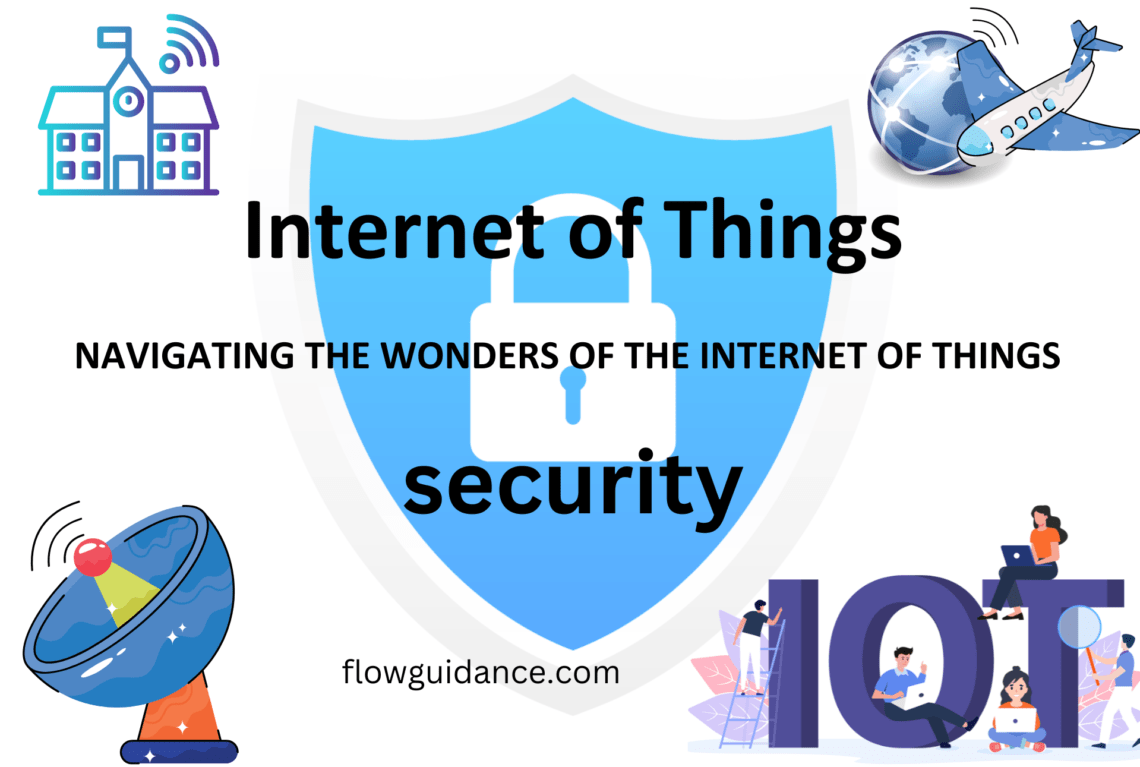Introduction Internet of Things security:
In an era dominated by technological marvels, the Internet of Things (IoT) has emerged as a transformative force, seamlessly integrating devices into our daily lives. From smart homes to industrial automation, IoT promises unprecedented convenience and efficiency. However, this digital revolution comes with its own set of challenges, prominently among them being IoT security.
The convenience of having interconnected devices raises concerns about potential vulnerabilities that could compromise our data, privacy, and overall system reliability. In this blog post, we will delve into the realm of IoT security, understanding its significance, the challenges it presents, common threats faced, best practices to adopt, and the future trends shaping this dynamic landscape.
Definition of Internet of Things security:
IoT security is the protective barrier standing between our interconnected devices and the evolving landscape of cyber threats. It is the practice of safeguarding the vast network of devices, sensors, and systems that constitute the Internet of Things. This security paradigm is critical for preserving data privacy, ensuring data integrity, and upholding the reliability of the entire interconnected ecosystem.
Significance of Internet of Things security:
The significance of Internet of things security is paramount, touching every aspect of our lives where IoT devices are omnipresent. In healthcare, it ensures the confidentiality of patient data; in smart homes, it shields personal information from malicious actors; and in industrial automation, it safeguards critical infrastructure from potential attacks. Real-world examples of security breaches underscore the urgency of fortifying our IoT systems against potential risks.
Key Security Challenges:
Securing the Internet of Things (IoT) is like embarking on a labyrinthine journey, filled with unique challenges that demand our attention. The first hurdle is the limited resources embedded within IoT devices. Picture these devices as having a limited brainpower and memory, making it tricky to implement robust security measures.
Now, add the complexity of a diverse array of devices, each with its own architecture and communication protocol. It’s like trying to speak multiple languages simultaneously. This diversity complicates the task of creating a unified security strategy, making it essential to adapt security measures to suit each device’s unique characteristics.
Data privacy concerns loom large on this journey. With the sheer volume of data generated by IoT devices, questions about privacy and potential misuse of personal information come to the forefront. Imagine your personal data traveling through the IoT landscape—ensuring its safety becomes a top priority.
Moreover, the lack of standardization in IoT security is a significant roadblock. There’s no universal rulebook that all IoT devices follow, making it challenging to establish consistent security practices across the entire industry. It’s akin to navigating a road with no traffic rules; chaos can ensue if everyone doesn’t follow a standard set of guidelines.
The challenge becomes finding the delicate balance between implementing robust security measures and maintaining the efficiency and functionality of these devices. It’s a tightrope walk that requires a thoughtful and innovative approach. Imagine securing a futuristic city – you want it to be safe, yet you don’t want to compromise its vibrant, connected energy.
In essence, navigating the complex landscape of IoT security demands acknowledging and addressing these challenges with a forward-thinking mindset. It’s about finding solutions that not only protect our interconnected world but also ensure that the benefits of IoT continue to enhance our lives without compromise.
Common Internet of Things Security Threats:
In the vast and interconnected realm of the Internet of Things (IoT), understanding the adversaries is paramount to constructing an impervious defense. The threats lurking in the IoT security space are diverse and demand vigilant attention to thwart potential breaches.
Unauthorized access stands out as a primary menace. Picture this: hackers attempting to breach the digital fortress of your IoT devices, exploiting weak passwords or uncovering vulnerabilities. It’s akin to an uninvited guest trying to access your home. Recognizing this threat is the first step towards reinforcing the gates of your digital stronghold.
Data tampering during transmission introduces a subtler but equally dangerous risk. Imagine your sensitive information being altered as it travels through the intricate web of interconnected devices. This threat jeopardizes the integrity of the data itself, emphasizing the critical need for safeguards against such manipulations.
Denial of Service (DoS) attacks emerge as a disruptive force in the IoT security landscape. Picture a scenario where your IoT devices are overwhelmed with traffic, rendering them incapable of performing their intended functions. It’s akin to a digital traffic jam, causing chaos and disrupting the normal functioning of devices. Identifying and preparing for such attacks is vital for maintaining the seamless operation of IoT ecosystems.
Vulnerabilities in firmware and software serve as open doors for potential cyber intruders. Picture these vulnerabilities as weak points in the armor of your devices, susceptible to exploitation. Recognizing and patching these vulnerabilities through regular updates is akin to fortifying your devices, ensuring they are equipped to withstand potential attacks.
In essence, comprehending these common IoT security threats is the cornerstone of effective defense. It’s about recognizing the potential entry points for adversaries and strategically reinforcing the digital infrastructure to withstand their onslaught. As we navigate the intricacies of IoT security, staying one step ahead of these threats is not just a proactive measure; it’s the key to ensuring the integrity and reliability of our interconnected digital world.
Internet of Things Security Best Practices
Ensuring the safety of your Internet of Things (IoT) devices is not a passive endeavor; it requires embracing proactive measures to build an unbreachable digital fortress. Let’s unravel the best practices that form the bedrock of a secure IoT environment, shielding you from potential cyber threats.
First and foremost, let’s talk about the gatekeepers – strong authentication. Imagine them as the guardians standing at the entrance, ensuring only authorized users gain access. This involves using unique passwords and, for an extra layer of protection, embracing multi-factor authentication. It’s like having a personalized key and a secret handshake, making sure only the right people get in.
Next up, consider regular software updates as the armor that shields your devices. Just as knights would regularly upgrade their armor for better protection, your devices need timely updates to patch vulnerabilities. This practice ensures that your digital armor remains resilient against the ever-evolving tactics of potential cyber adversaries.
Now, picture data encryption as the secret code that only you and your devices can understand. It safeguards the information as it travels through the digital highways, ensuring that even if intercepted, it remains secure. Encrypting data is like sending it in a sealed envelope that only the intended recipient can open.
To further fortify your digital haven, embrace the concept of network segmentation. Imagine your digital world divided into secure neighborhoods. If one area is compromised, the impact is contained, preventing the entire digital city from falling into chaos. It’s akin to having firewalls between different sections of your digital landscape.
Last but certainly not least, consider the foundation of your digital haven – choosing vendors committed to security. It’s like selecting architects and builders with a track record of constructing robust structures. Opting for reputable vendors ensures that your IoT devices are built on a trustworthy foundation, minimizing the risk of vulnerabilities from the very start.
In essence, these IoT security best practices are the pillars of a resilient digital infrastructure. They empower you to navigate the ever-evolving landscape of cyber threats with confidence, ensuring that your interconnected world remains secure, efficient, and a source of convenience in your everyday life.
Future Trends in Internet of Things Security:
As technology advances, so does the arsenal available for IoT security. Emerging trends like blockchain, artificial intelligence, and machine learning are revolutionizing the landscape. Blockchain’s decentralized and tamper-resistant nature, coupled with the predictive capabilities of AI and machine learning, offer innovative solutions to fortify IoT security. Staying abreast of these trends is crucial for adapting to the evolving threat landscape.
Conclusion:
In conclusion, the Internet of Things has undeniably transformed the way we interact with the digital world, bringing convenience and efficiency to the forefront. However, this digital revolution demands a parallel focus on IoT security. Understanding the challenges, recognizing threats, and implementing best practices are essential steps in safeguarding our interconnected future. As we navigate this evolving landscape, staying informed and proactive is our best defense against the ever-present cybersecurity threats in the realm of IoT. Prioritizing IoT security today is an investment in a safer, more connected tomorrow.
we delve into the ever-evolving realm of IoT, witness its real-world applications, and explore innovations driven by industry leaders like Google. For further exploration and insights, feel free to visit flow guidance.





